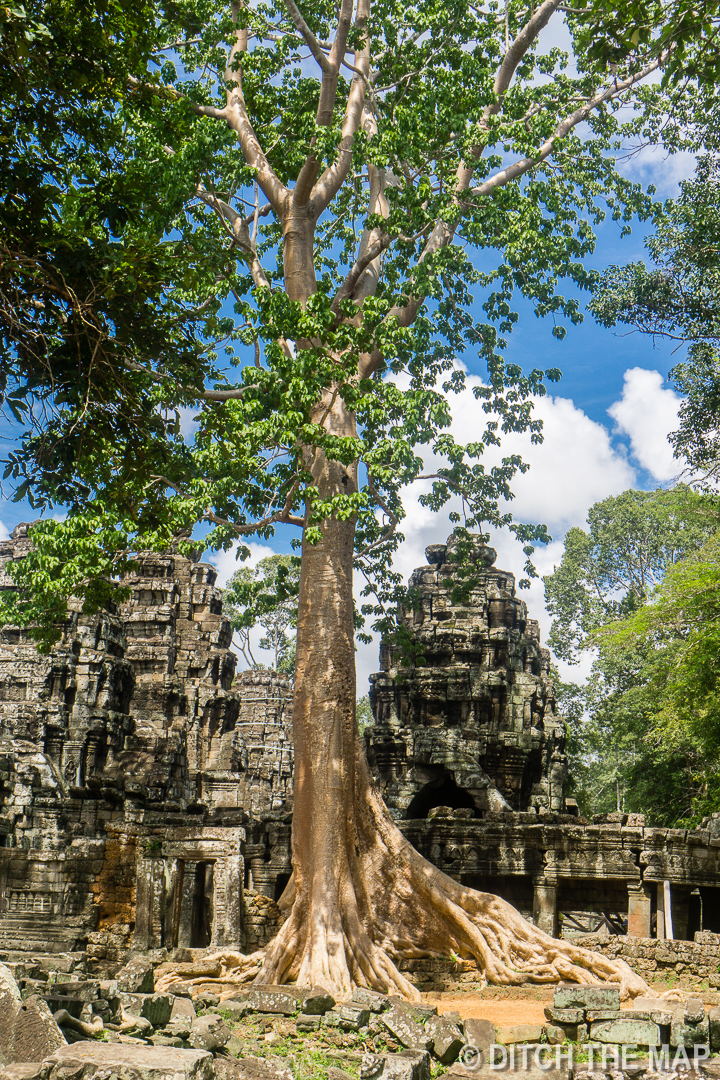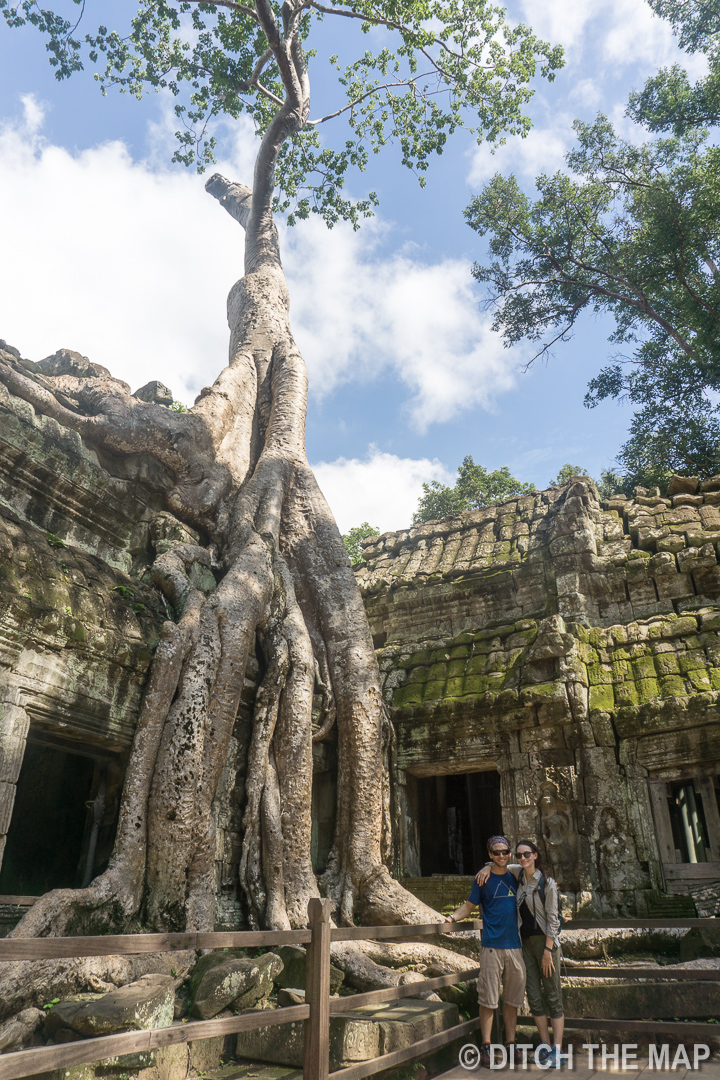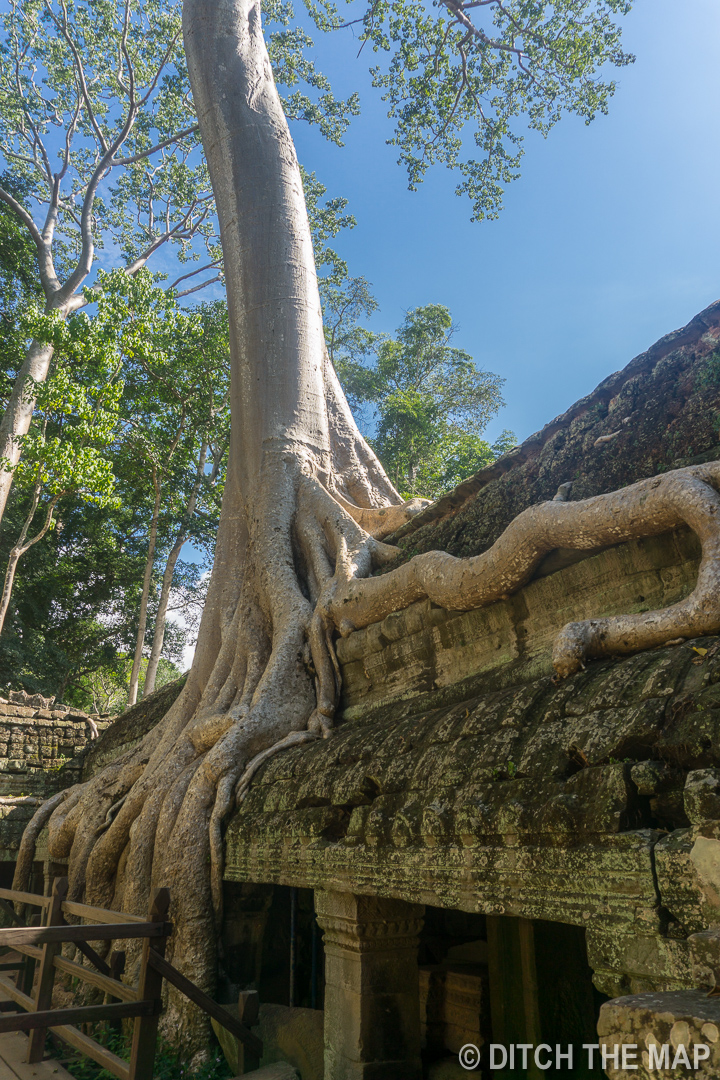3 Days in Siem Reap, Cambodia
/August 27-29, 2016
Overlanding Into Cambodia
To get to the city of Siem Reap, Cambodia we had a choice between taking an air-conditioned van to the Thai-Cambodia border then switching to a non air-conditioned van for another 5 hours our other option was a direct VIP bus from Bangkok. The first option was only 300 baht ($8.50) but, we decided on the second choice, for 800 baht (~$24). It seems we've gotten a bit lazier with travel. We thought that by taking the VIP bus we would avoid some of the corruption at the border, but we were wrong. Check Bookaway for more Bus options in Cambodia.
Bribes at the Border
Our Hotel Room in Siem reap, Cambodia
Just prior to arriving at the Cambodian border a staff member on the bus told us that we had to pay 1200 baht (or $40 USD) for the visa on arrival and that we could stay on the air-conditioned bus and he would take care of everything for us. I knew however that the actual visa price was only $30. Where the extra $5 goes, we don't know- his pocket? Or perhaps he shares the profit with the officers working in the immigration office. It's a well-known fact that many officers take extra long to issue a visa on arrival unless you hand over a bribe. I told the bus employee that I knew the legitimate price of the visa to $30. He continued to tell me that is was actually $35 and that $5 was to expedite the service at the border. He also said that if we didn't have 2 passport photos we needed to pay an extra $6. I insisted but he persisted that I would not get it for $30, that I could pay even more than $40 if I tried to do it myself, depending on the mood of the immigration officer.
Everyone on the bus complied except for Sylvie and myself--we did not want to perpetuate the cycle of corruption. We decided to take our chances and get the visas ourselves. We were told that we could expect to wait 2-3 hours for our visas to be completed and hold up everyone on the bus, clearly the bus staff was trying to deter us. But, low and behold, we were in and out of Cambodian immigration within 5 minutes. Ha! And we only paid $30 for the visa. Above the desk in immigration the sign clearly stated "visa $30." On a hand written sheet of paper on the desk however there was an additional $2 charge for the visa service. We told the officer that we would not pay as the Ministry of Foreign Affairs says the visa is only $30, begrudgingly he accepted this truth and completed our visa.
A naive man on our bus had said, "C'mon Mate, it's only $10". I explained it isn't about the money but rather sustainable tourism. He along with everyone else on the bus was willing scammed from the bus company, paying extra for convenience, not having to leave the bus and air-conditioning.
Corruption and Sustainable Tourism
$10 may not sound like a big deal in order to potentially 'save a few hours' at the border, however the sheer act of 'going along' with the corruption is propagating the problem. If everyone were to stop paying the bribes, the bribes would hold no weight. It is a prime example of the game theory, 'Prisoner's dilemma', Unless everyone abides by the same rules then everyone suffers. I understand the case that 'one person cannot change anything' but if you apply this logic to other areas of life then no one would vote, recycle, conserve water, etc. Also, though we don't always recognize it, our actions are in a feedback loop to our brain. Some call it Karma but it is a tangible thing. By committing these minor infractions, insignificant as they my appear, we are positively reinforcing the actions such that they become easier the next time. You can thank brain plasticity for that.
There is almost no accountability in countries like Cambodia and as long as we keep giving the bribes the corruption has no reason to stop. We have the responsibility as tourists to help these countries be the best they can be and not contribute to their plight.
Cambodia has a large standing military, mostly comprised of high-ranking officials. They collect large salaries, consisting of huge sums of bribes. I recently learned that many of the immigration officers pay their superiors monthly bribes for their jobs. Since these lower-ranking officials do not make much money they have to collect bribes from tourists and other people. When talking to our Tuk-Tuk driver about where all the money from Angkor Wat goes, he just told us that they go into the pockets of government workers. It's no wonder that so many of the country's uneducated farming community supported the Khmer Rouge. The feeling of utter hopelessness is ubiquitous. Even today people have almost no faith in their government.
Another area of sustainable tourism I've been wanting to discuss: "Paying too Much For Things Really Hurts The Local Economy"
It's easy to just pay the 5 dollars the cabbie is demanding when it's raining outside and you want to get back to your hotel room across town. However it's important to pay what is fair and reasonable for the area and not to use another place's price as a reference. Everywhere we go there are children and adults peddling their merchandise on the street. So many people give in and pay extorted prices, or donate a few bucks and buy something. I am sure they do this out of kindness but it actually is devastating the region and the person they buy from when they pay inflated prices. It's only natural that locals try to earn as much money as possible by asking exorbitant prices from naive tourists. There are a couple reasons why it benefits to do research as a tourist, not give in to temptation, and to only pay a reasonable price. I'll provide an example to illustrate my point:
By paying more than what a well-functioning market would suggest a tuk-tuk driver earns a disproportionately higher income. This drives the supply of tuk-tuk drivers up. Drivers continue to demand the higher prices, despite their increase in supply, because many naive tourists don't know what a reasonable price is. Prices are nontransparent since there are no standardized price lists and everyone charges different amounts. Instead of all driver's accepting less money for more rides, as what would happen in a transparent market, drivers simply have fewer customers per day. Over time this brings down the salary of the tuk-tuk drivers and they must increase the amount they hassle the customers for rides. One driver told us the night before he had waited until 4 in the morning for his customer to leave a bar. The tuk-tuk drivers become desperate for work. As of now they receive 1-3 customers a day and earn $200-$300/month. As customers continue to overpay, the driver will simply reject 'reasonable' prices and just wait for customers to exploit.
The phenomenon described above occurs in all areas of tourism--lodging, food, etc. The cost of living increases significantly in the 'touristic city' such that eventually the locals not working in tourism (nurse, engineer, teacher, etc) struggle to keep up with the ever-increasing prices. Eventually everyone moves to the tourism industry, which in turn destroys the local culture. A positive benefit is that many rural farmers move from surrounding areas for work. Although overpaying seems like a small issue and some may even think it helps people by giving them more money, it pushes the incentives out of whack and prevents a successful and sustainable economy from forming. Children can now make more money by dropping out of school to sell magnets at temples. We, as tourists, have a responsibility to help contribute the the success and honest prosperity of the areas we visit.
I'm sitting in a classy place in Siem Reap now eating a roasted sweet potato with chickpeas, beet hummus, and some white frothy drizzle (luckily there are still some authentic places a few streets outside of town). The wait staff is extremely happy and eager to serve us. They have smiles on their faces and both have moved from rural villages into the city for work. Their families are farmers. However starting monthly salaries for guesthouse workers, ticket checkers at temples, or waitstaff is only $80/month). Despite the low monthly incomes of the guesthouses and restaurants it's the western investors (owners) who make a bulk of the money flowing in from tourism.
The City of Siem Reap
The city has changed so much since I last visited. Initially I was very sad to see the city almost devoid of the regional culture and replaced with Starbucks, upscale cupcake shops, and air conditioned pubs. This is not the Siem Reap I remember form 7 years ago. I realize that it is the experience in the city of Siem Reap 7 years ago that I loved so much and miss. Whether or not the city changes my experience would surely be different each time I visited. Who am I to say what a city should be like? Cities (and countries) are dynamic, always changing. Being in Siem Reap now just makes me appreciate cities that are less influenced by the greater world and have unique regional cultures.
Pub Street in Siem Reap, Cambodia
Pub Street in Siem Reap, Cambodia
The Angkor Wat temple complex is situated a mere 20 minute drive north of the city. While there is a nice museum and other ways to occupy one's time in the city Sylvie and I walked around Pub Street and the Angkor Night Market. Pub Street is a happening stretch of bars and restaurants freckling both sides of the road. Prices are even higher here and elsewhere. Prices have gone up 2x to 3x since my last time here. Too bad most of the money is going to foreign investors. The Angkor Night Market of 7 years ago has been updated to meet the needs of the modern common tourist. What was once a mixture of local and foreign culture has transformed into a street with Australian frozen yogurt shops, tea cafes, and pricey tickets. Fortunately we were able to find a warung where we got sautéed Bak Choy for a whopping $2. In this part of town an hour massage runs almost $10, while just two streets over you can get one for 3$/hr. Foot massages can be found for $1.5. It really tells you something when a slice of American-style cheesecake costs the same as an hour massage. Locally owned establishments (guesthouses, restaurants, cafes, etc.) are cheaper and it's a good habit to give them the service because the money spent will be all directed back in the country.
Khmer Dancing Performance
Our first night we enjoyed $0.50 draught beers while watching a Khmer dancing performance.
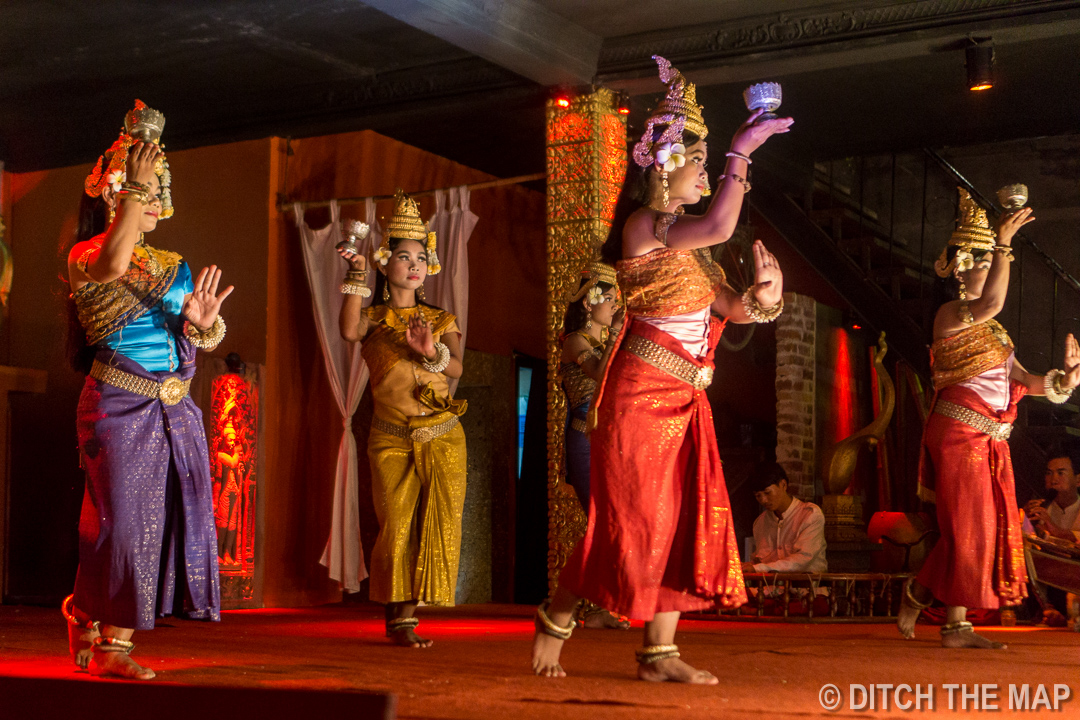

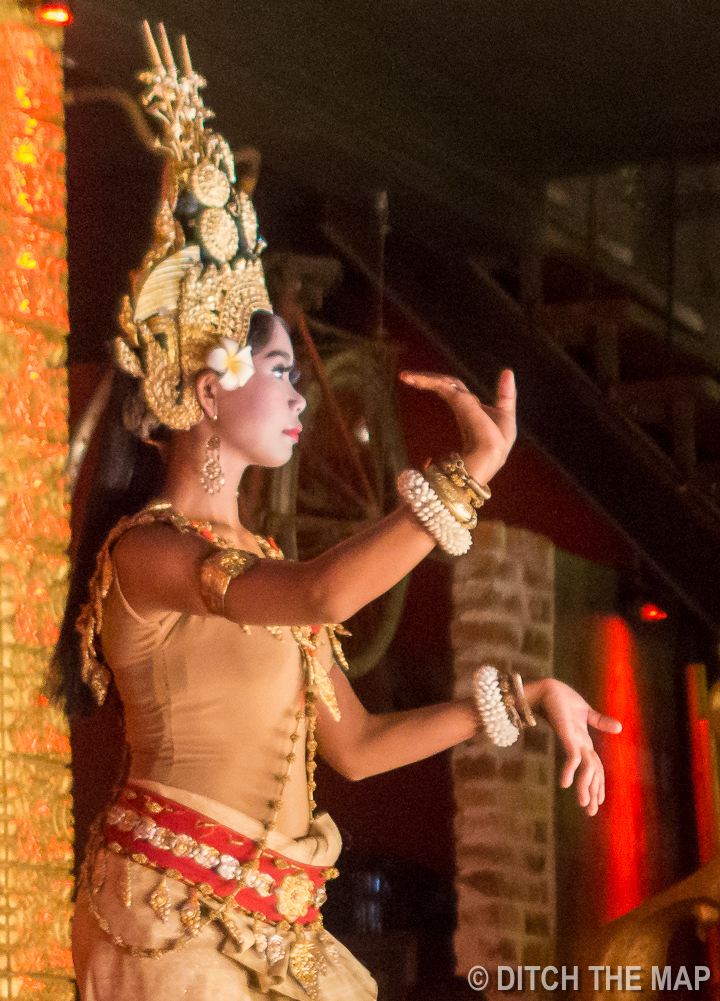
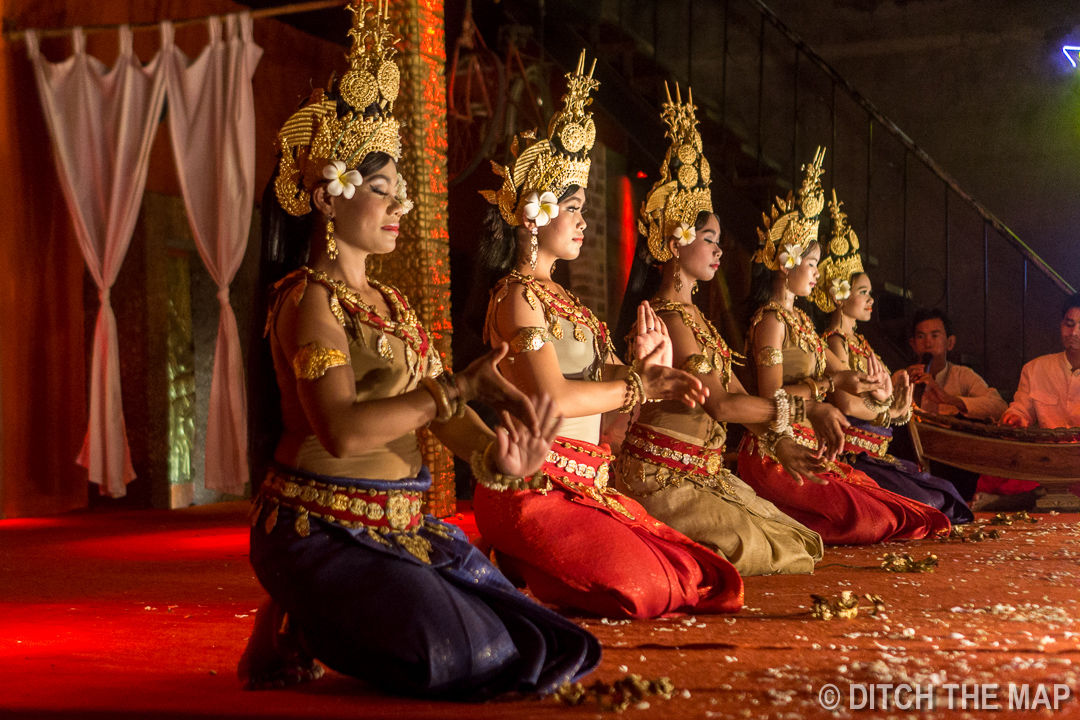

Authentic Khmer Dancing in Siem Reap, Cambodia (click to view)
Authentic Khmer Dancing in Siem Reap, Cambodia (click to view)
Authentic Khmer Dancing in Siem Reap, Cambodia (click to view)
Authentic Khmer Dancing in Siem Reap, Cambodia (click to view)
Cultural Insights
Tuk-Tuk Drivers Waiting for Their Customers Outside Angkor Wat, Cambodia
Our Tuk-Tuk Driver: While waiting for our tour group at Angkor Wat we had a long informative conversation with our Tuk-Tuk driver. Who, eager for the work, picked us up at 4:30am sharp to see sunrise over Angkor Wat. By 8:30am he had been waiting around in the parking lot for us to return from watching sunrise. He explained about his family in a rural settlement 50km north of Siem Reap and that he and his brother have been working in the city for the last 3 years. He had originally worked in a guesthouse for a year and used that time to save up for his tuk-tuk, which cost his $1000 USD. He explained about his earnings as a guesthouse employee and now as a driver. He told us about a Filipino customer who paid $125 for 4 days of his services. Our driver said he had thought about becoming a guide (where wages can be up to $500/month or higher) but that the course was expensive. Many people in his village are leaving to move to Thailand since wages are much higher there. A day's worth of work (guesthouse, wait staff, ticket checker, etc.) can earn you $2-$3 USD in Siem Reap, while in Thailand it can earn you $10.
Our Tour Guide: Our tour guide spoke English very well, a must if you want to be a tour guide. During the times in the van, between temples, he spoke to us candidly about his life and answered many of our questions. He told us that many men are unmarried in Cambodia. It's the man's family that provides a dowry to the prospective wife. This amount can range from as low as $4,000 up to $18,000 or higher. It's paid in the form of cash to the women's parents. The girl's parents decide how much the man will have to pay for their daughter's hand in marriage. After the marriage the wife's parents then return the money in the form of helping the new family to set up a business or build a house. So many people lost their parents during the war of 1975-79 to the Khmer Rouge that now many men must pay the dowry themselves. Many man cannot afford this and end up not marrying. Our guide lost his parents when he was 5 and lived in an orphanage until he was 22 years old. He is 37 and his friends are between 35-40, all of them are unmarried and have no hopes of being able to afford marriage. A tour guide's salary is among the higher in the city and the fact they cannot afford a wife is startling and the implications to the future population can be grave.
People Get Hassled by Cambodian Children (click to view)
Cambodian Children Selling Postcards (click to view)
Angkor Wat Temple Complex (and other temples)
It is low season now and the temple has only 3k to 4k daily visitor, compared to the over 10k people that visit the temple complex a day during high season. The morning clouds prevented any sort of visible sunrise but we were still happy to arrive at the temple so early. The majority of people going for sunrise have to leave their hotels around 4:30am and by 6:00am, after sunrise, most are already en route back to their hotels for breakfast. They then return at 8:30-9:00 for a day tour. We, however, stayed around during this time--we got to walk around when only a handful of people were inside.
We visited 4 or 5 temples without our tour from 9:00am to 7:pm. Having started our day at 4:30am we were exhausted when we finally got back to our hotel 15 hours later at 7:30pm.
We visited Angkor Wat, Angkor Thom, Bayan, and Ta Prohm (the famous temple made famous by the 2003 Tomb Raider movie).
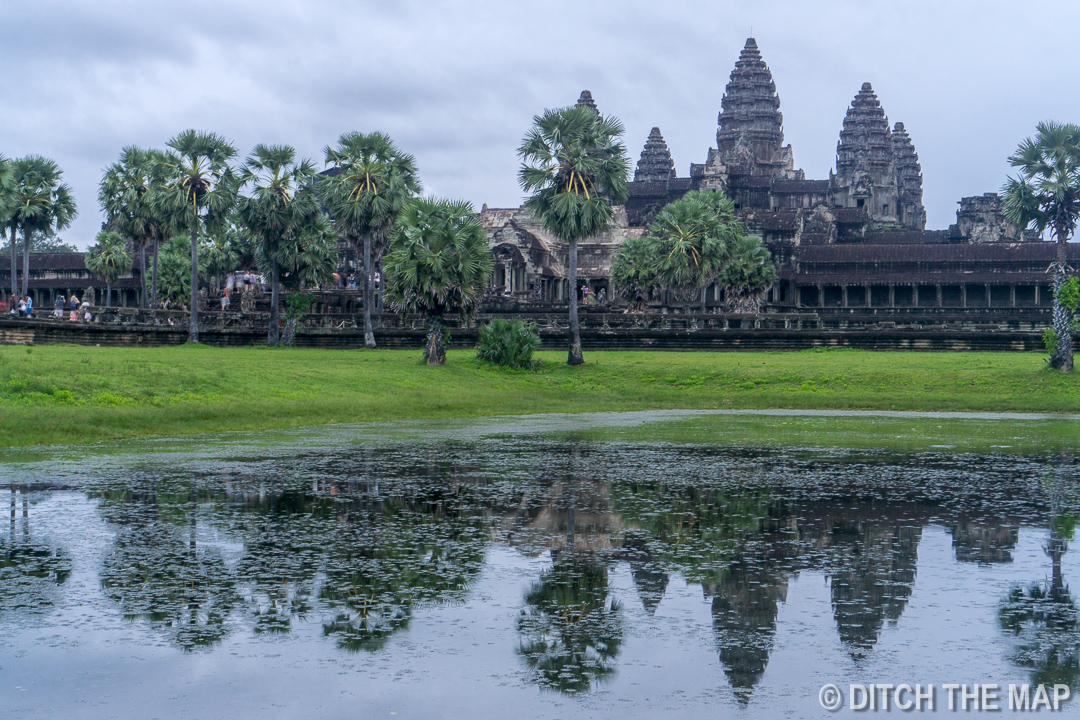

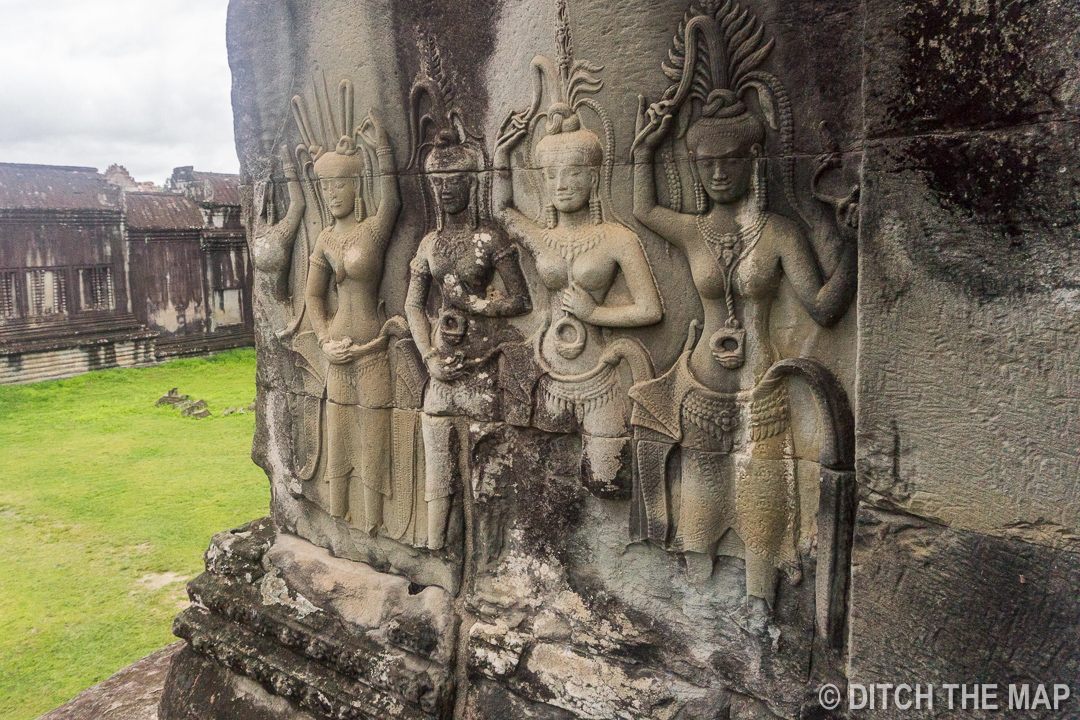
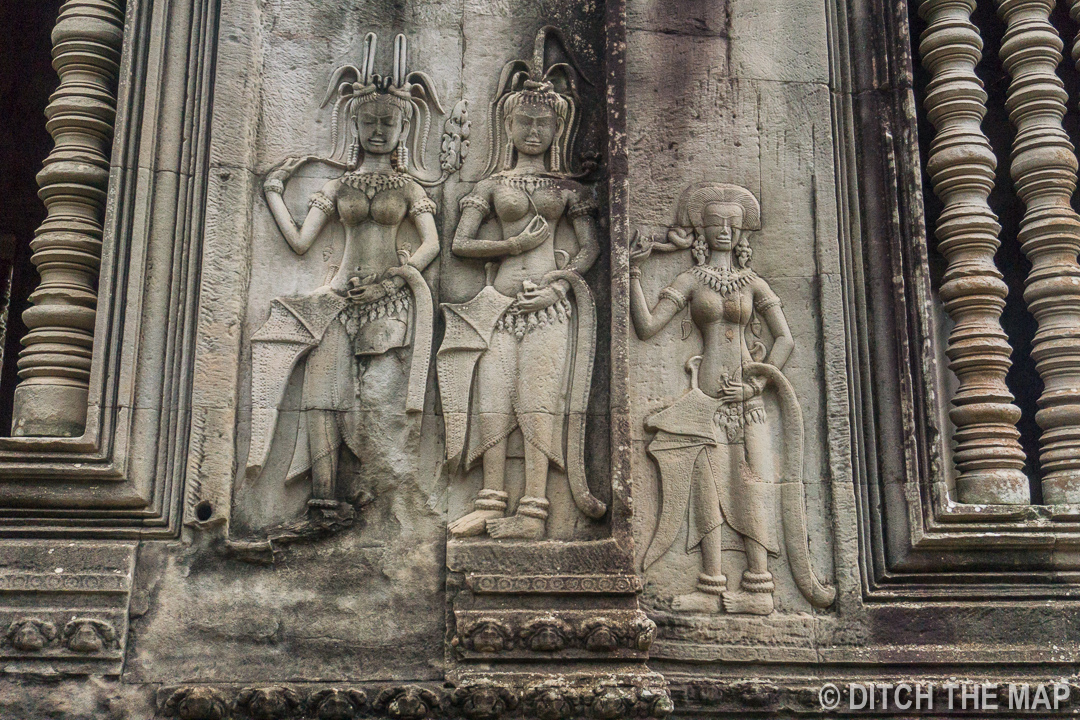

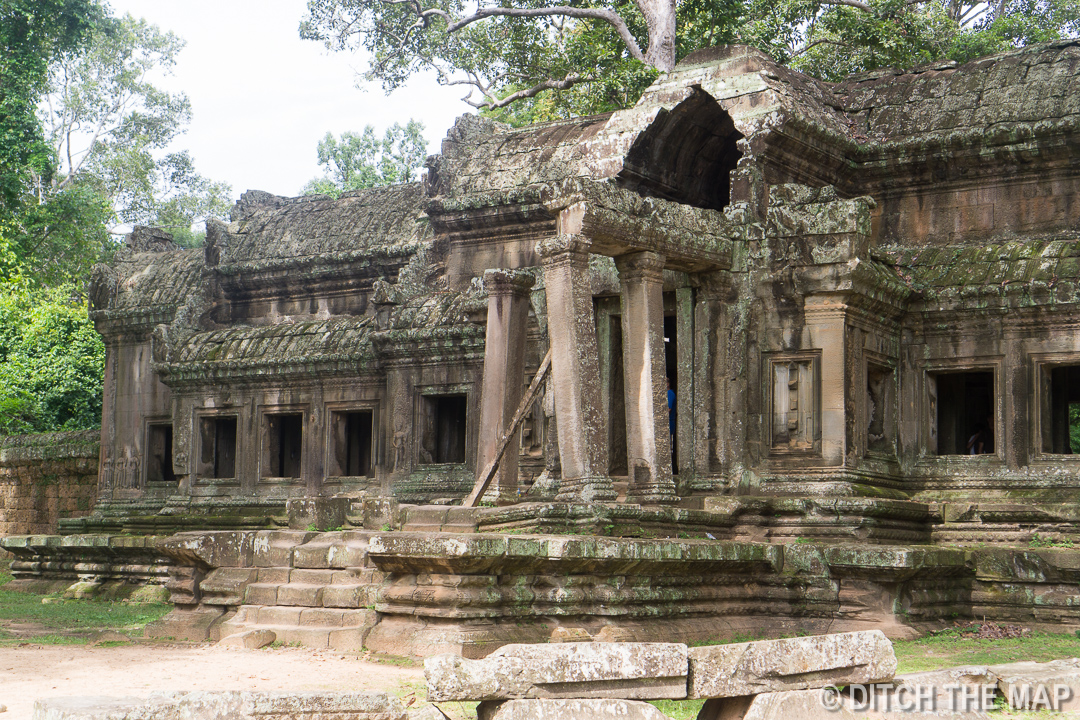

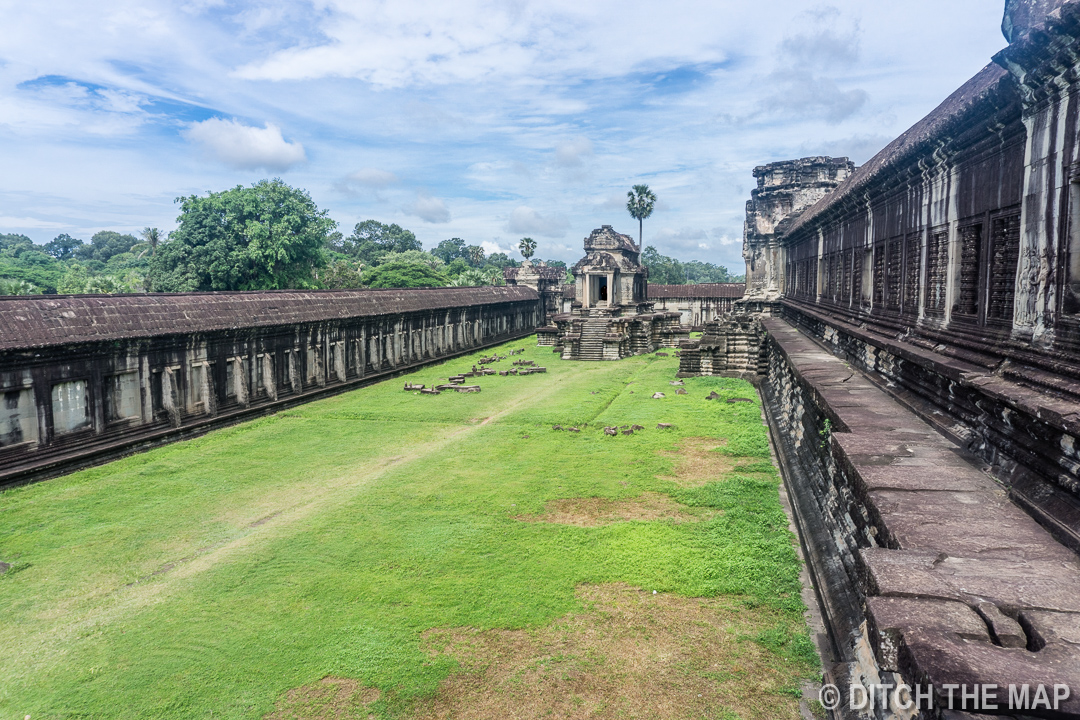
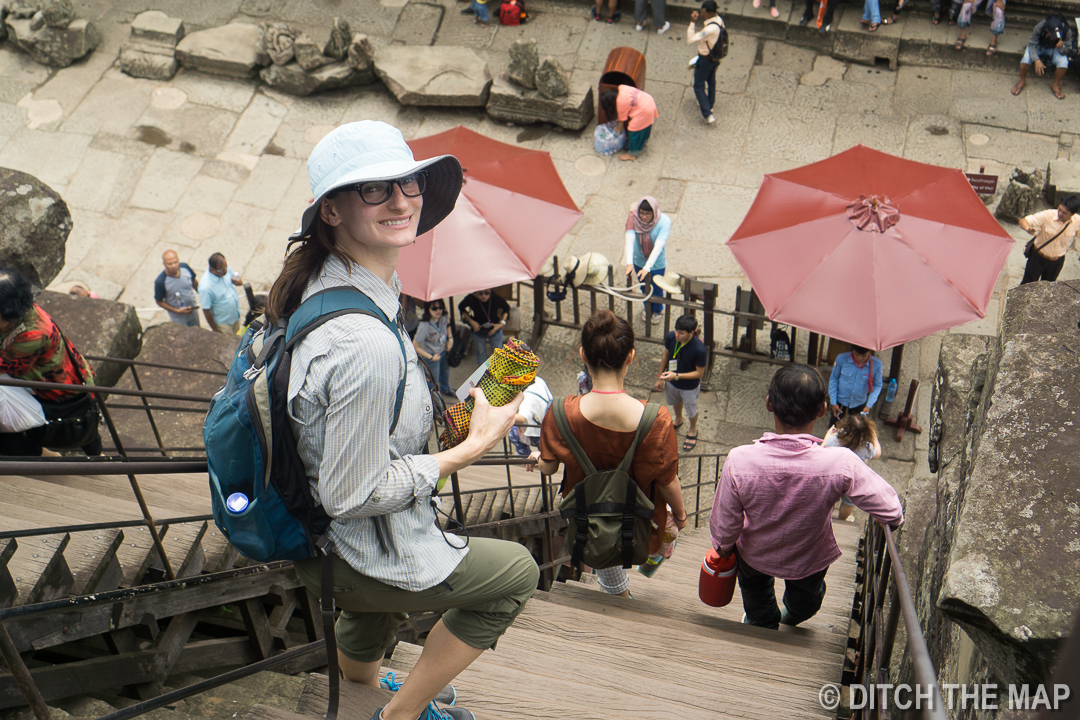
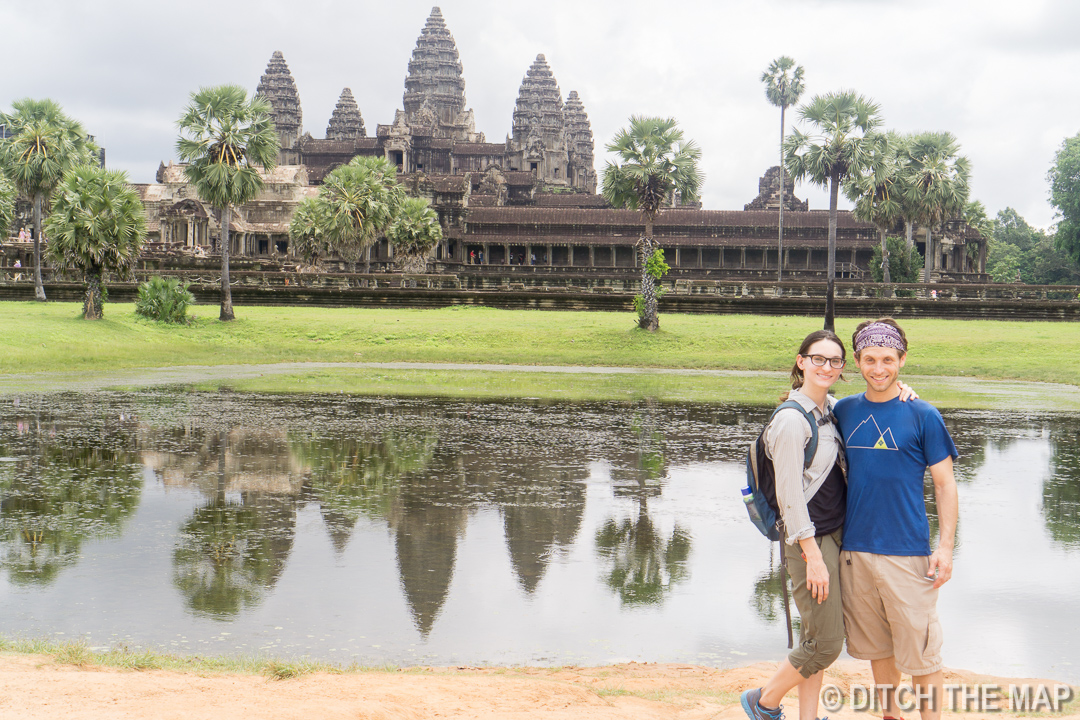
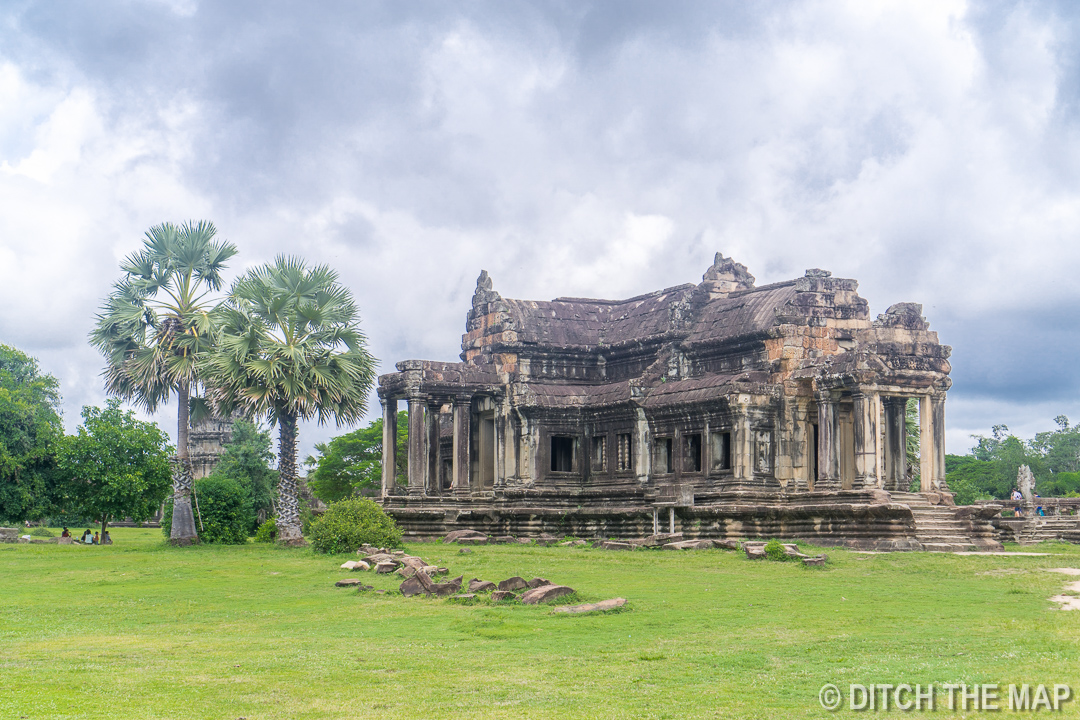
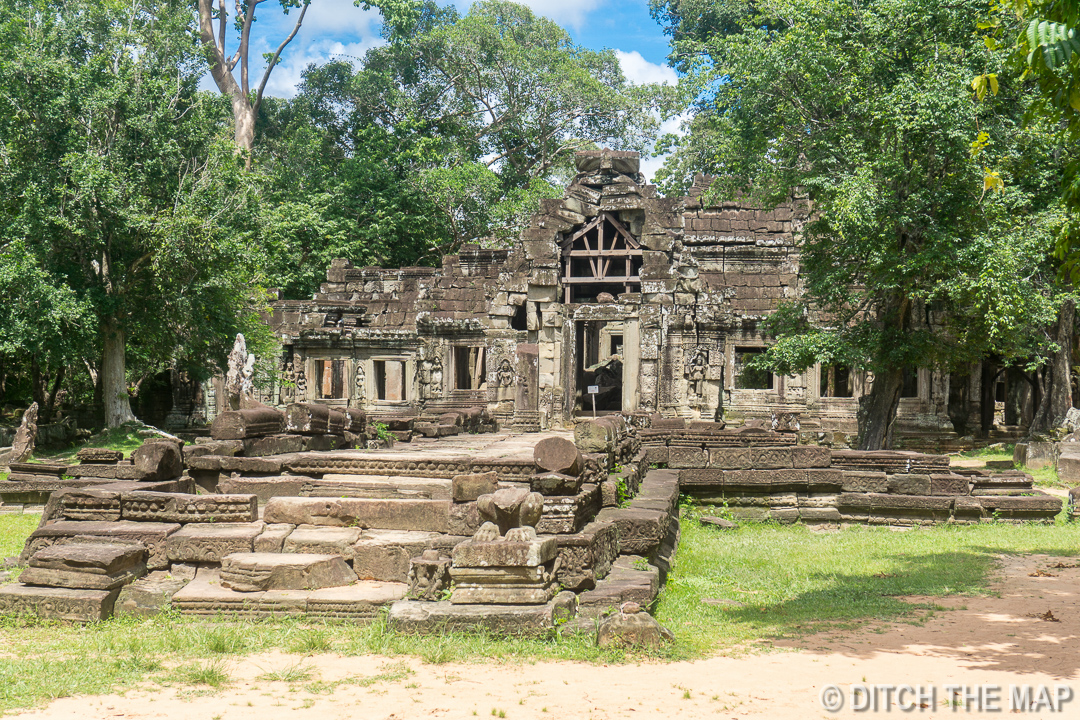
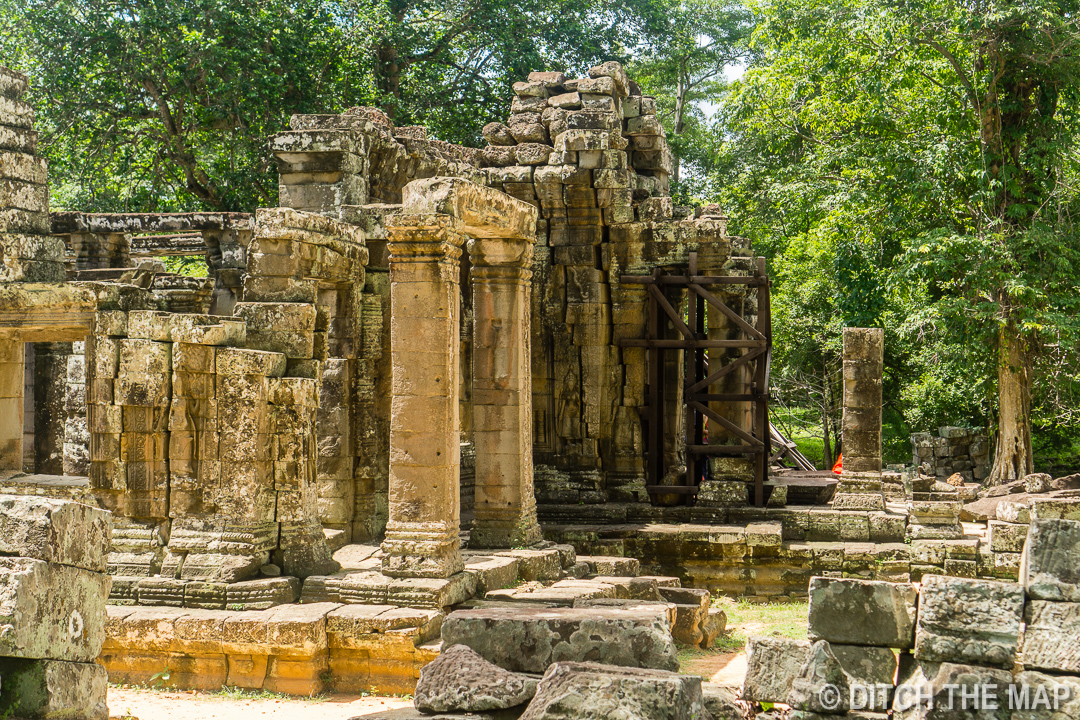
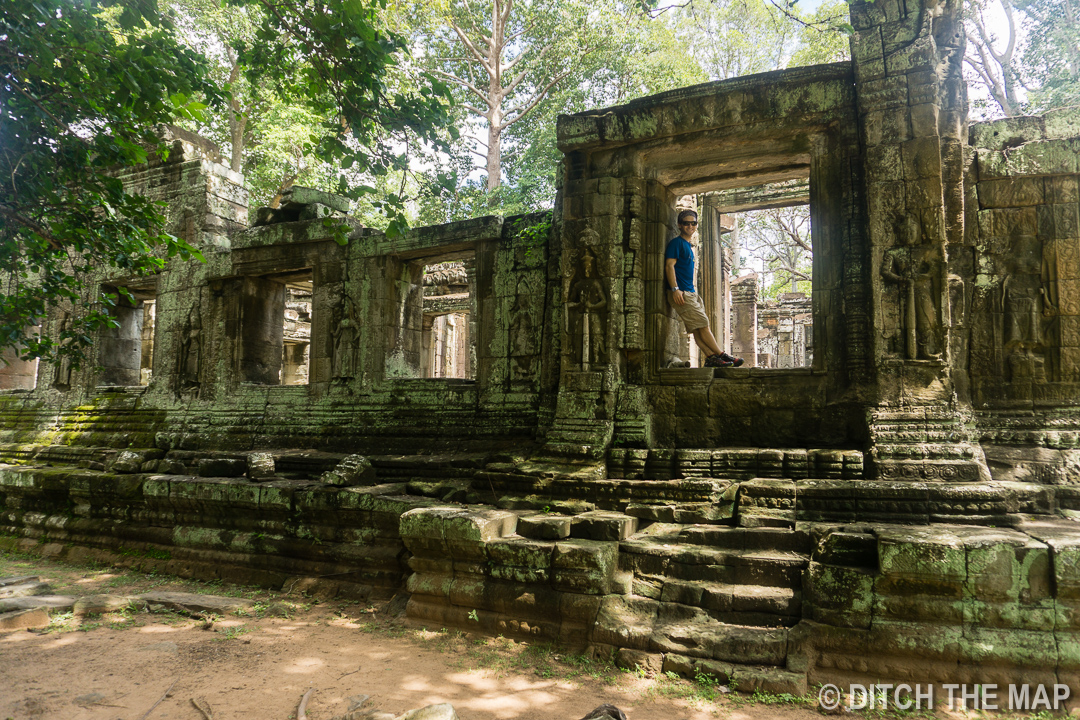
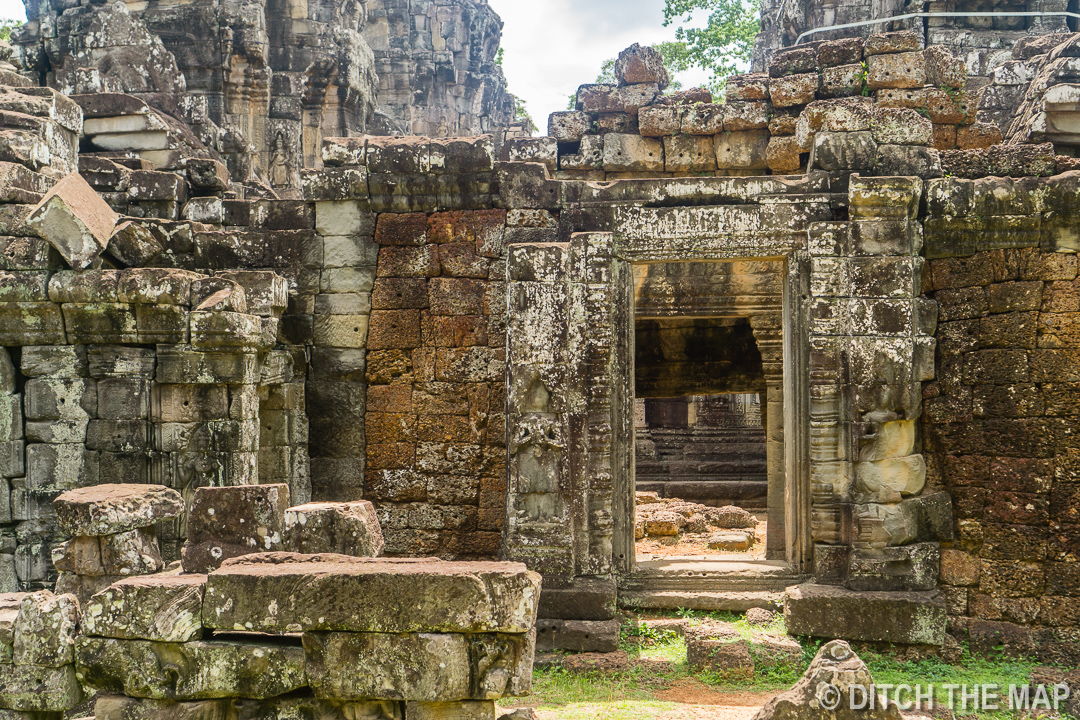
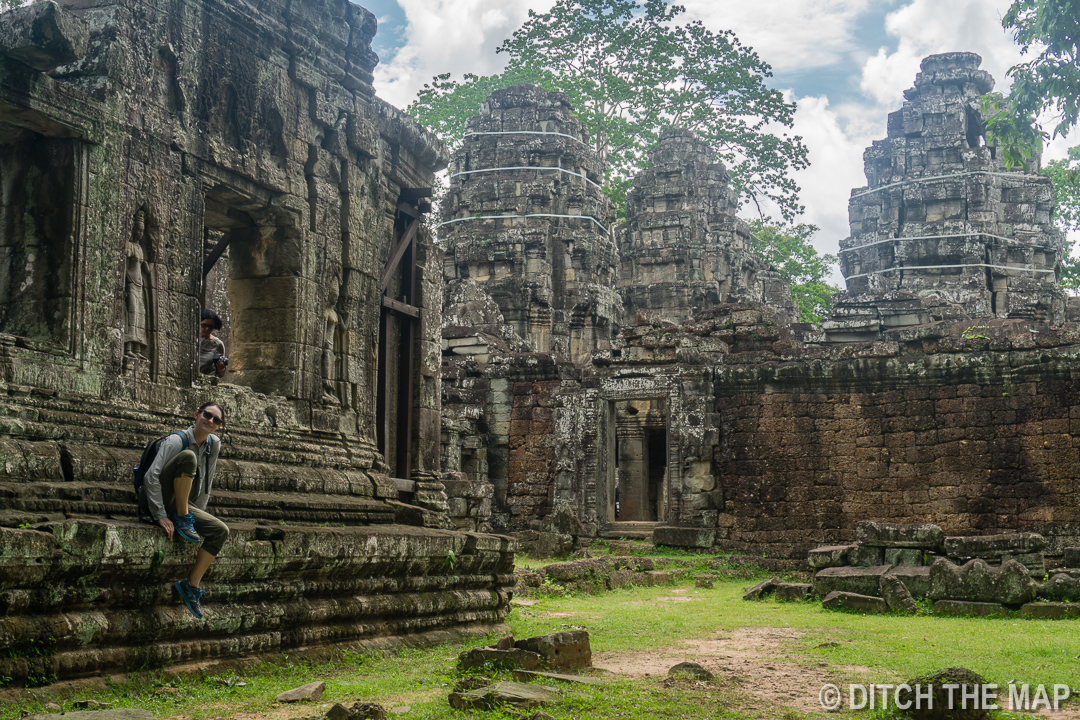
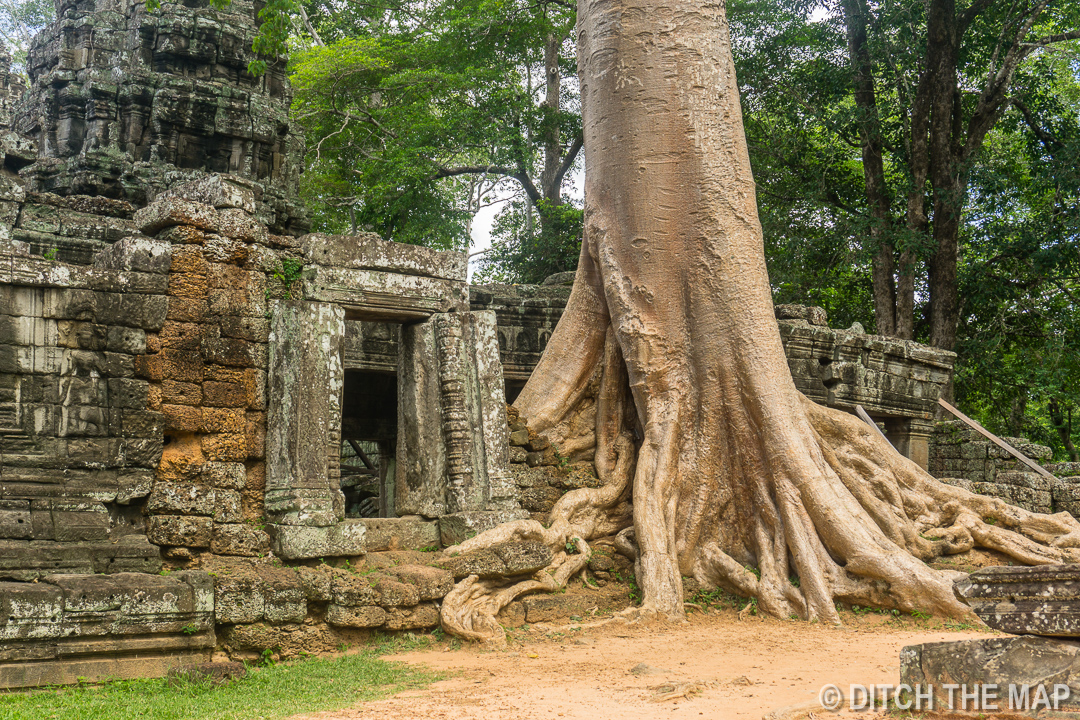
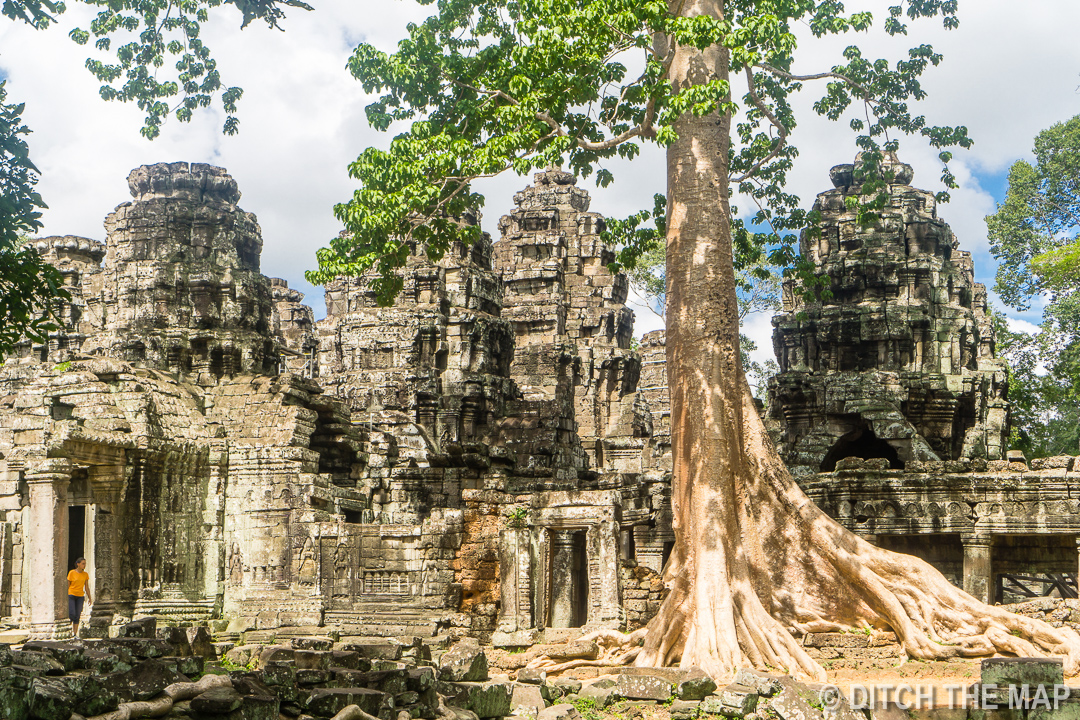

Angkor Thom outside Siem Reap, Cambodia (click to view)
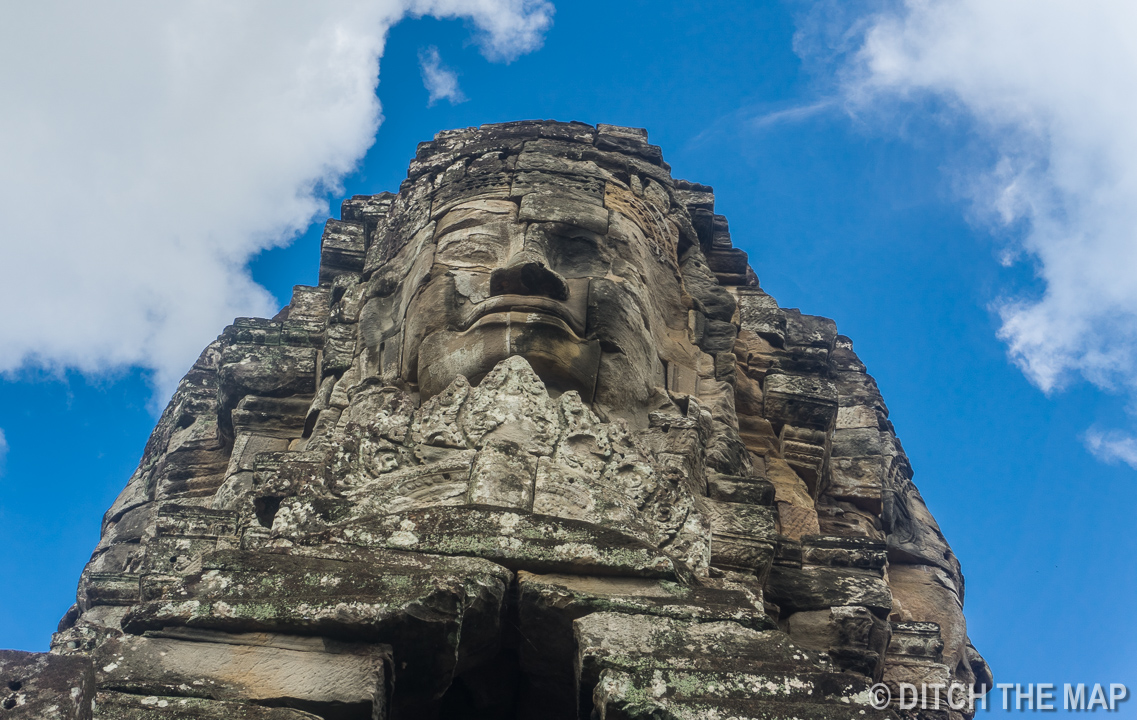
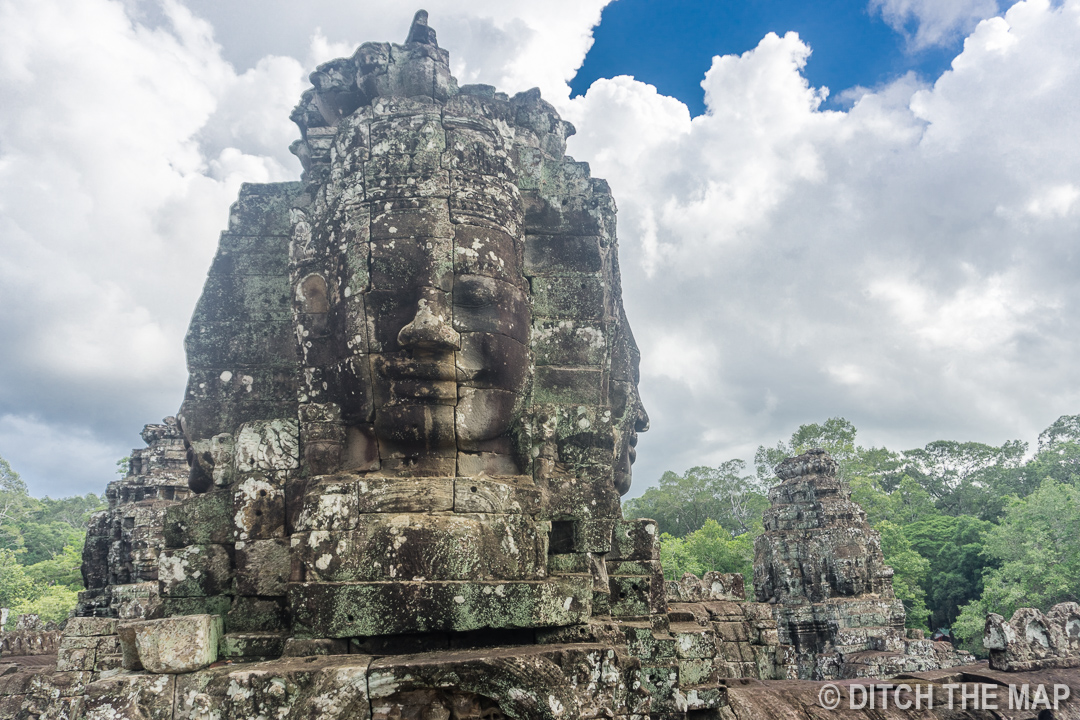
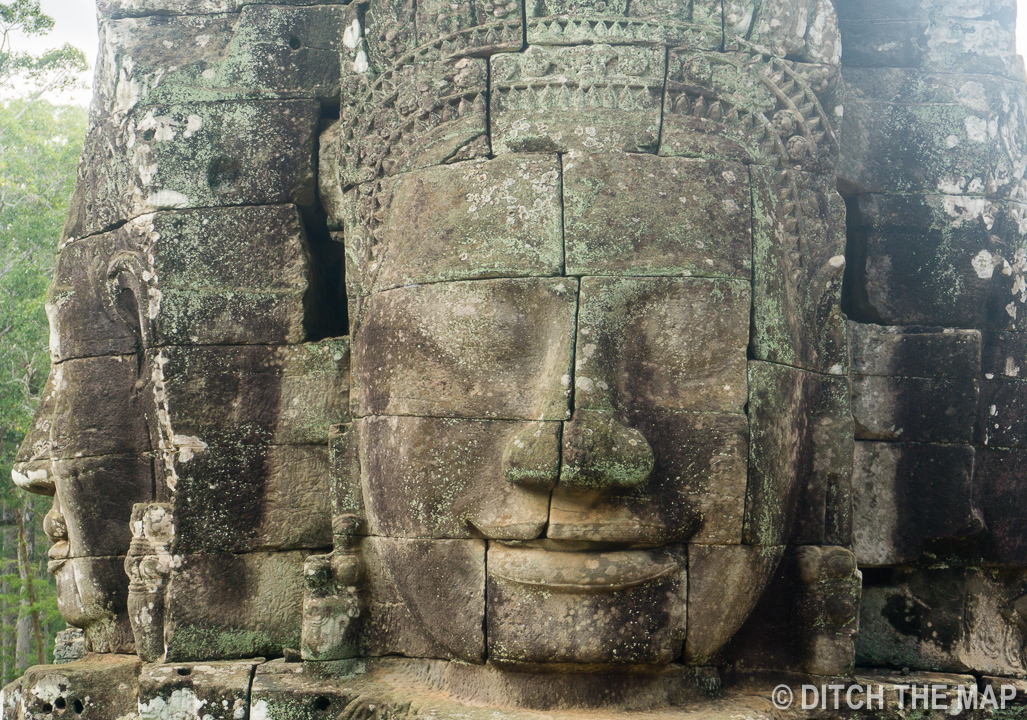
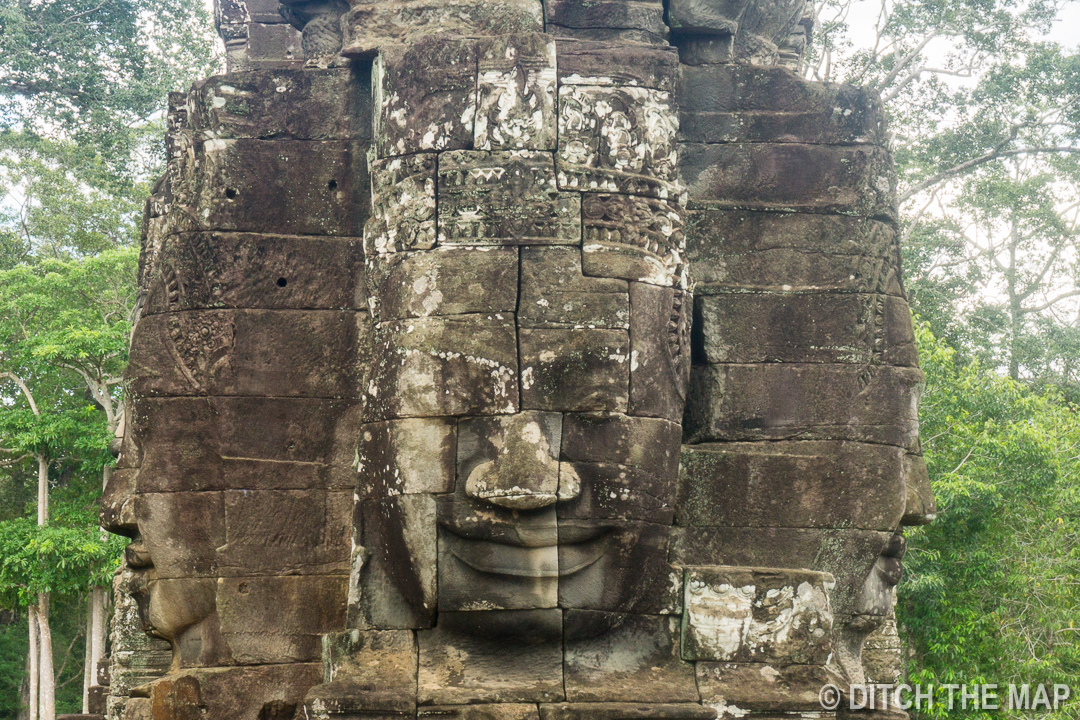
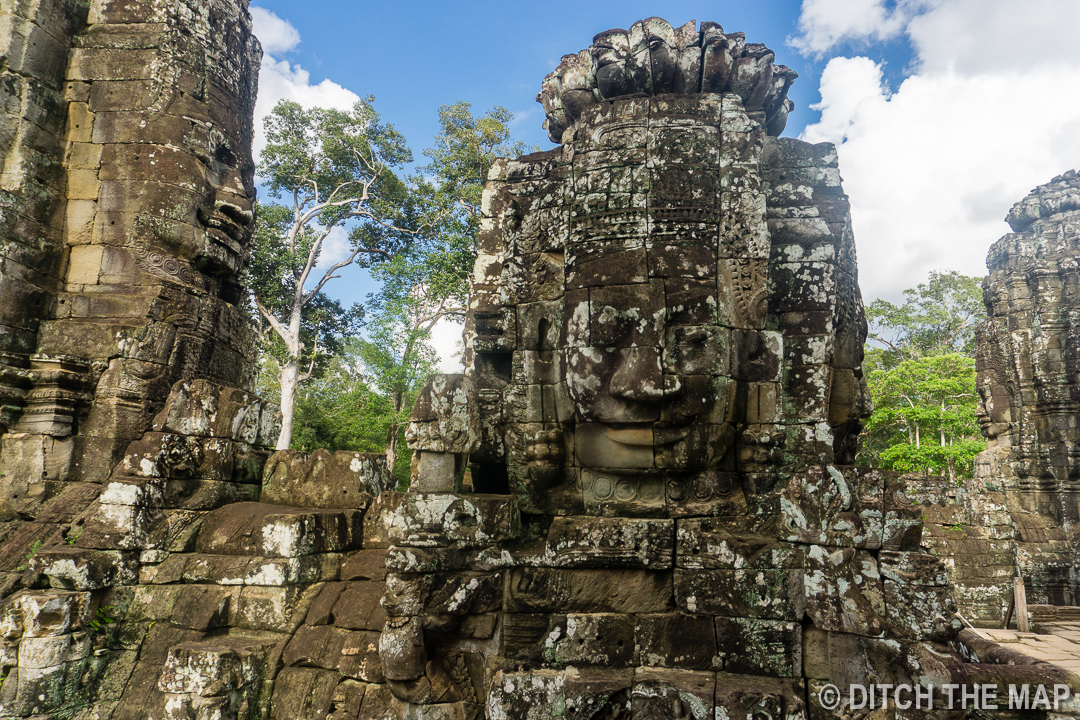
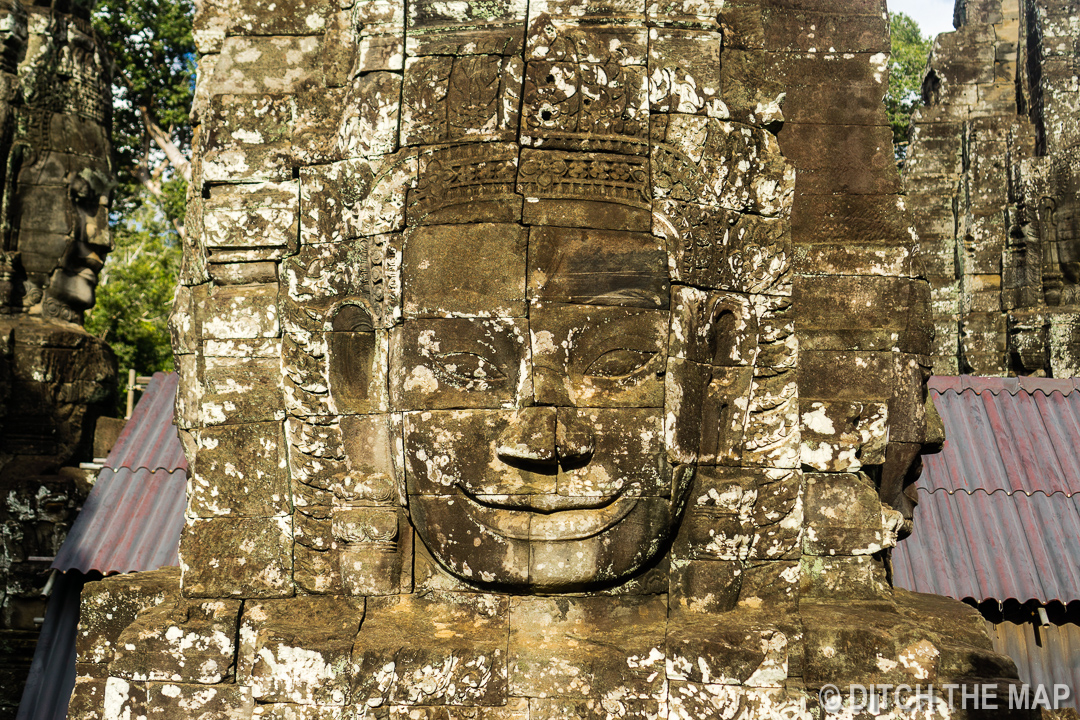
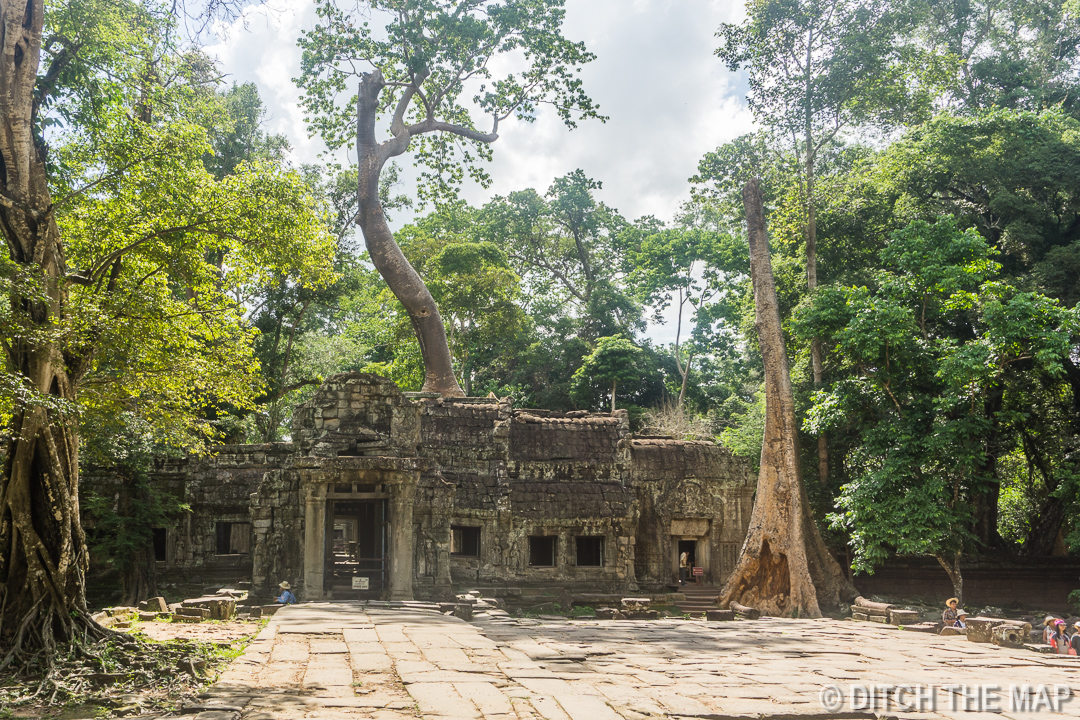
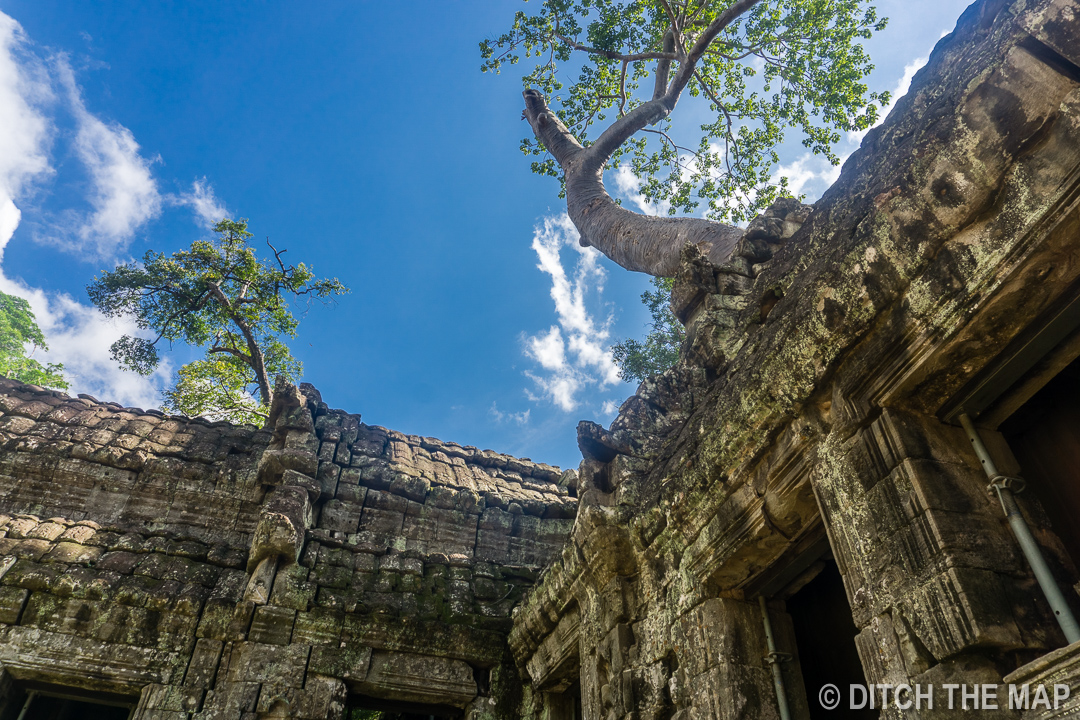

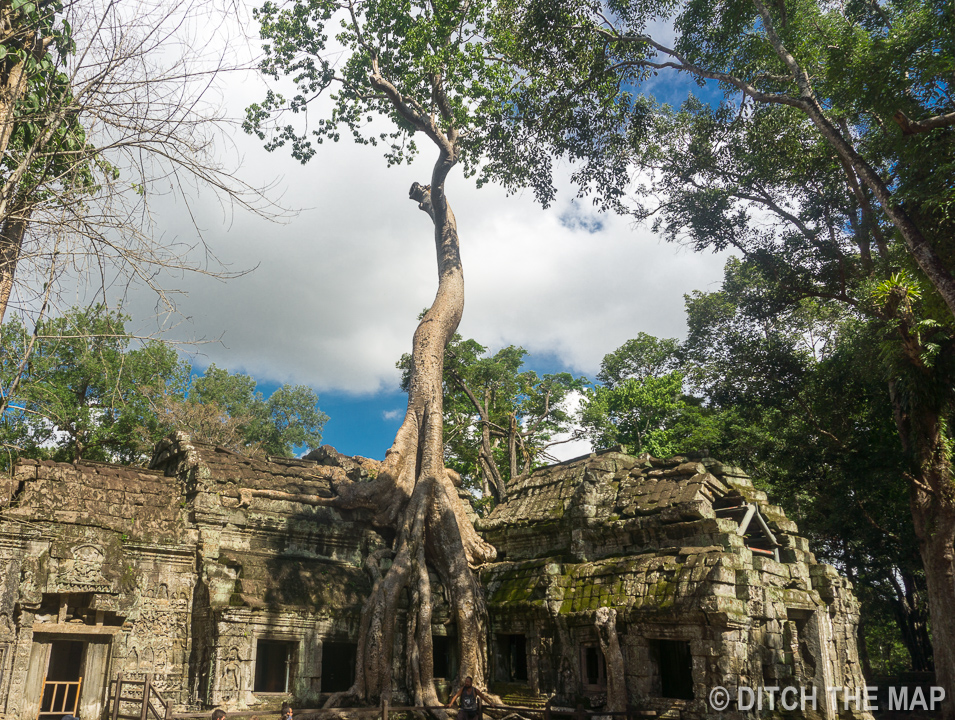
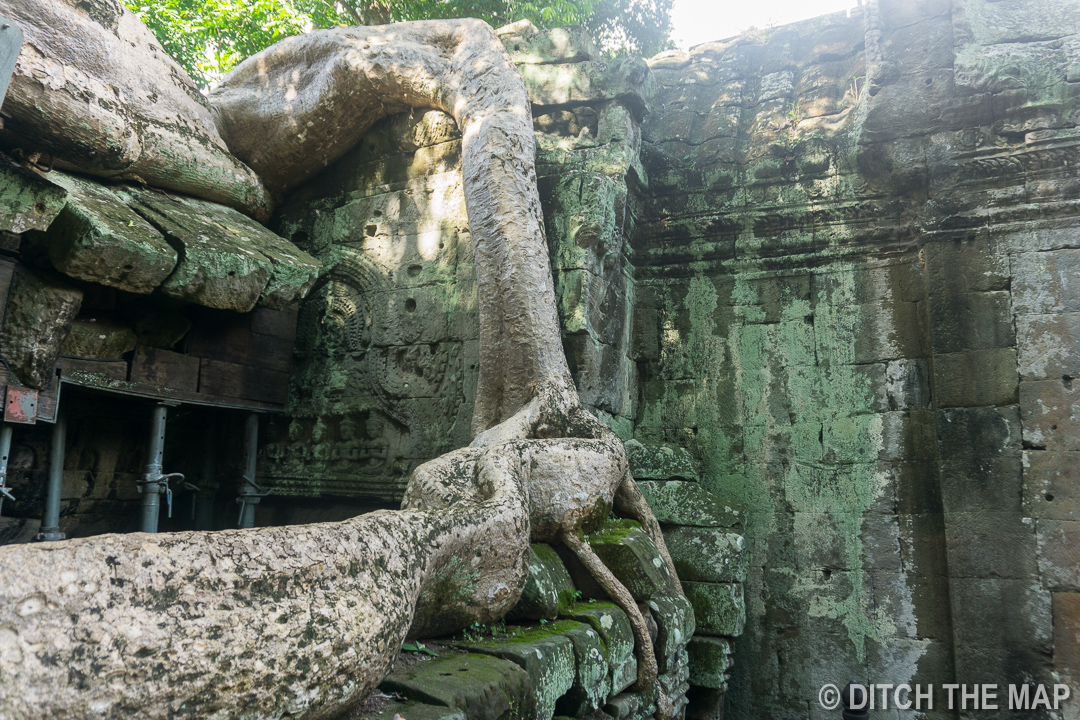
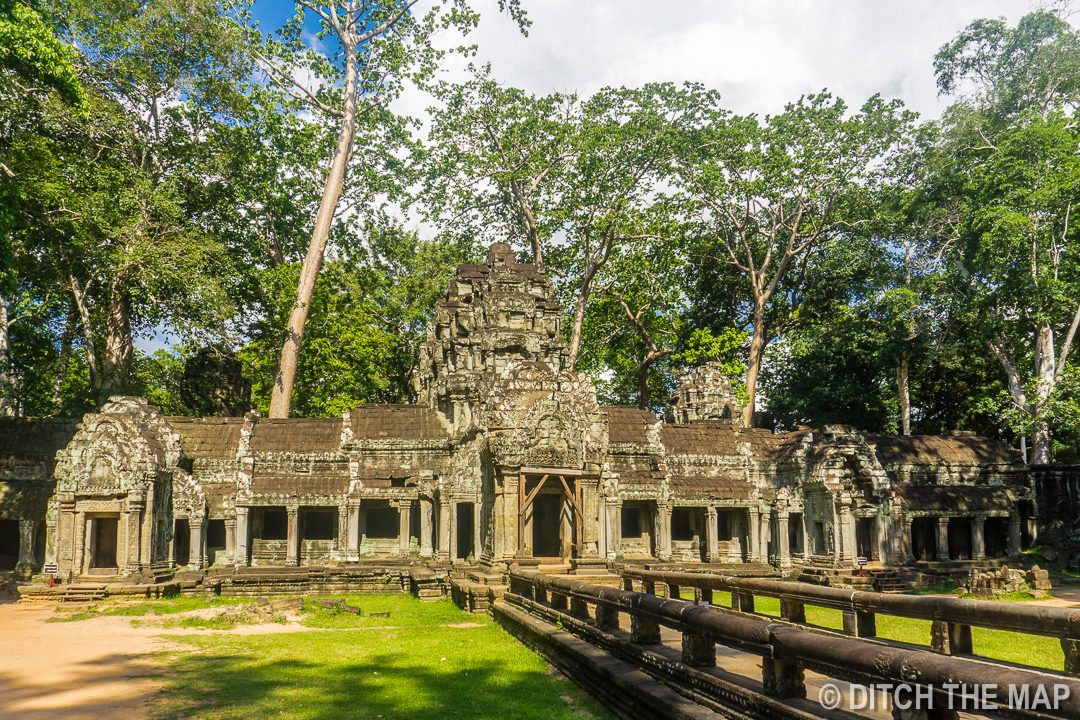
Our Next Destination
We're going to the unexplored eastern part of Cambodia where we'll work with elephants for a day and then hike 18km to a rural Bunung village the following day. A nice change of pace after our $4 hour massages in Siem Reap!





